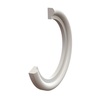Milk coupling seals
Milk coupling seals have been specifically developed to seal screw couplings (according to DIN 11851) and are predominantly used in the food, pharmaceutical and chemical industries.
The special design of these seals avoids dead spaces in the application. This significantly reduces the risk of contamination and odour transfer.
When purchasing a milk coupling seal, you should consider the seal's shape and size, and the material used for the product. The certificates with which the seal complies are also important. Most products comply with US (FDA) and European legislation (EC1935).
Shape of a milk coupling seal
ERIKS offers a variety of milk coupling seals. There are two types:
- Milk coupling seals without a lip;
- Milk coupling seals with a lip.
A lipped milk coupling seal has more material for filling the groove and gap, which reduces the space where contamination may possibly occur and improves system cleaning.
Milk coupling seal dimensions
The nominal diameters of a dairy coupling ring depend on the size of the flange in your application. What if you don't know the size of this flange? You can determine the correct standard based on the inner diameter and outer diameter of the coupling.
The dimensions of our milk coupling seals comply with international standards: DIN 11851 and SMS.
Milk coupling seal materials
We offer milk coupling seals made from different materials, such as EPDM, FKM, HNBR, NBR, PTFE and VMQ (silicone). Each material is the basis for a unique compound; a recipe of different material components that result in the desired specific mechanical properties when combined.
You should make sure that the material used for a milk coupling seal matches the conditions of your application. So you should always consider the temperature, the pressure, the medium and the duration. It is very important that you also take into account CIP (Clean in Place) and the products you use in order to avoid problems associated with chemical resistance. SIP (Steam in Place) is also a factor to consider in some cases. The summary below provides concise information about the most popular materials and their properties.
- VMQ milk coupling seals
Most milk coupling rings are made of VMQ. This material is commonly known as silicone and is very flexible. It is resistant to both low (-60°C) and high (+200°C) temperatures. Some VMQ milk coupling seals can be detected by X-ray or metal detection equipment. If pieces of the ring end up in the foodstuff, the detection equipment triggers immediately and rejects the contaminated beverages or foods to prevent them from reaching the consumer.
- NBR milk coupling seals
Some milk coupling rings are made of NBR, also known as nitrile rubber. This rubber material is ideal as a seal for certain oils. NBR on the other hand is not very resistant to UV radiation, ageing and high temperatures (above +120°C).
- EPDM milk coupling seals
EPDM is also commonly used as a material for milk coupling rings. This material is well adapted to various solvents, hot water and steam. All EPDM milk coupling seals can withstand low temperatures (down to -50°C) and are resistant to UV radiation and ageing. Some compounds are also suitable for high temperatures (up to +150°C). EPDM is also a suitable material for SIP processes.
- FKM milk coupling seals
FKM is the material to use for applications involving strong chemicals and high temperatures. This material is also known by its brand name, Viton, and can withstand temperatures of up to +200°C. Furthermore, the standard compounds are resistant to many strong acids, but not always to hot water or steam. Only a few special FKM compounds are suitable for applications that involve unusually low temperatures (-40°C or lower).
- PTFE milk coupling seals
PTFE, also known by the brand name Teflon, is highly resistant to strong acids and bases. This material is not wear-resistant, and unlike the elastomers mentioned above, also not elastic.
Are you looking for more information about the chemical resistance of our materials? Please refer to our Chemical Resistance Guide.
Ordering milk coupling seals at ERIKS
What legislation do ERIKS' milk coupling seals comply with?
Most of ERIKS' milk coupling rings comply with European (EC1935) or American (FDA) legislation. Some compounds have both certificates. The individual product page indicates which regulations that particular product complies with.
What prices does ERIKS charge for milk coupling seals?
The price of our milk coupling seals is shown on the product pages. If the price is not immediately visible, it will be displayed after you have logged in.
What delivery times does ERIKS offer for milk coupling seals?
The delivery time for a specific milk coupling seal is indicated on the page for that product. If you require a product more quickly, choose a different material that also works in your application.
If you need help finding a good alternative, please contact us via the enquiry form.
Can I order custom seals?
Are you looking for a milk coupling seal of a different size, shape, colour or material? Or do you need a seal for a special application, or one that meets specific certification requirements? Let us help - contact us via the enquiry form.











